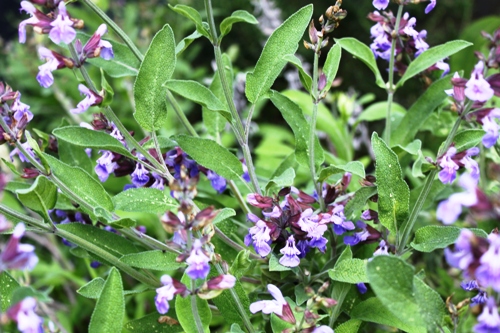
Virgil Evetts
When I was small, my mother took a part-time job packing herbs for what was at the time New Zealand’s only boutique herb (and spice) importer, Ma Hellion. The shop was close to my school, so I’d often stop by on the way home, ostensibly to see mum, but also to sniff the herbs. Yes, I was a weird kid, just ask anyone. Nothing flicks the nostalgia switch for me like fragrance, and whenever I smell dried herbs today, I straight away think of that dusty and stupefyingly scented shop. But, as fond as I am of these memories, I do not have much love, nor time, for dried herbs in the kitchen. With only one or two exceptions, dried herbs are pointless shadows of their garden-fresh counterparts. Fresh really is best, but it pays to be discerning.
The herb sections at most garden centres present an increasingly bewildering range of possibilities, including – to my annoyance – a good many things that aren’t really edible. Good luck cooking with wormwood. But unless you enjoy wasting water, there is no point growing weird and wonderful herbs just for their point of difference. It’s taken me a while, but these days, for the most part, I can resist the many temptations of herbal exotica and focus on a small selection of tried and true herbal troopers -plants that have stood the test of time, and the many trials of the kitchen.
Basil (Ocimum basilicum)
Basil is so popular and widely grown that it only gets a mention here because its omission from any list of essential herbs would be nigh on sacrilegious. Although a perennial in the tropical climes of its native India, in temperate zones basil grows as a rather delicate annual. It’s popular with snails, aphids, caterpillars, the occasional urbane sparrow, and can be shredded by wind and rain. That said basil is easy enough to grow in the summer months, and as long as you grow it en masse (to allow for losses), there is little chance of it failing to produce a good crop. Old fashioned ‘sweet,’ or Genovese, basil is still the safest bet for most situations. This undeservedly passé cultivar has an excellent fragrance (rather like cloves), and consistently tender leaves.
As a general rule, the smaller the leaf of basil cultivars, the stronger the flavour and fragrance. For sheer intensity, the diminutive Spicy Globe is unsurpassed and a first class choice for pesto; but in my gardenis quickly smothered by melons, cukes and other creeping summer stars (thus my preference for the slightly milder but lankier common variety). Coloured and lettuce- leaf basils are certainly very pretty, but are a rather insipid lot.
The only passable way of preserving basil is chopped, mixed with a little oil and frozen. This can be used as a base for pesto throughout the year. For the love of whatever deity floats your boat, do not EVER use dried basil. Shudder.
Coriander (Coriandrum sativum)
I despised coriander (herb) when I was a kid. It smelled like stink-bugs to me, and although my attitude has matured, it turns out that I wasn’t too far wrong. The dominant flavour of coriander leaf is composed of a very similar set of chemicals to those found in the defensive secretions of shield (or stink) bugs. Aren’t you glad I told you?
Always plant coriander seeds directly into garden beds, and don’t bother with shop-bought seedlings. The plants grow like the clappers in a warm sunny spot, but resent the slightest disturbance to their roots (like transplanting), and take similar umbrage to desiccation. Both scenarios result in the plant assuming death is imminent so it had better hurry up and make babies (seeds). This is the beginning of the end: the fine leaves produced on the flower stalks are unpleasantly rank, and unless you are after a crop of coriander seeds (a fine and underrated spice), it’s best to tear the plants out at this stage. Even when grown unmolested and in favourable conditions, coriander is an unusually short-lived plant, so successive sowing is strongly advisable.
Coriander leaf is best known locally for its use in South-East Asian cuisines, particularly seafood-based Thai curries and salads, but it also represents one of the defining flavours of authentic Mexican cooking. Coriander root is used in the preparation of many curry pastes, and can be frozen, but fresh leaves cannot successfully be preserved by any means. As with basil, coriander leaf should never be cooked.
Thyme (Thymus vulgaris)
I feel a bit sorry for thyme; it’s so overlooked and taken for granted, and is grown, more often than not, as an ornamental by many otherwise competent cooks. The thing about thyme is that it’s very potent: a few leaves nibbled raw will initially swamp the palate with their resinous perfume, before numbing the tongue completely. Thyme is, however, an archetypal cooking herb. Its subtle use in stews or with roast, grilled and even fried meat, can be quietly transformative.
I returned from a trip to Central Otago once with a couple of wild thyme plants dug up on the hills above Arrowtown. This feral variety is the source for the region’s magnificent thyme honey, and is the toughest and most potently flavoured thyme (and believe me, there are plenty to choose from) I’ve come across. Common, or ‘wild thyme’ as it sold at garden centres, is a very decent and close second.Thyme plants can live for decades, but without periodic assaults from scorching summer sun, hungry goats and the odd dusting of snow, it gets hideously and unproductively scraggly. For the best results give it a good hair cut every year after flowering, and starve it of water now and then.
Dried thyme leaves are ok for use in stews and other slow-cooked wet dishes, but can be somewhat spiky.
Thyme-scented hamburgers
The following recipe for hamburger patties is to my mind one of the better examples of the subtle splendour of thyme.
450 grams prime beef mince
1 glove garlic, crushed
1 teaspoon ground white pepper
½ teaspoon finely chopped fresh thyme
¼ cup breadcrumbs
1 egg –beaten
1 teaspoon salt
In a large bowl mix together all ingredients until smooth. Refrigerate and rest for at least one hour. Fry a test piece and adjust seasoning to taste . Form into patties slightly larger than palm of your hand, and no thicker than your little finger. Fry a or grill until browned on both sides. Serve in toasted burger bun/baps with your favourite burger fillings.
Parsley (Petroselinum crispum)
It’s been frightfully fashionable in recent years to turn one’s nose up at curly leafed parsley, in favour of the apparently superior qualities of flat-leafed, or Italian, forms. I’ve been a pretty noisy passenger on this bandwagon too, but now must conclude or confess that I actually prefer my parsley curly. Perhaps it’s not as richly flavoured, but it is very tender and easy to chop, whereas flat-leafed parsley can be tough as old gardening clogs. In my experience curly leafed parsley is slower to bolt to seed too, which is a big advantage to a time-poor gardener like me.
My two most-beloved ways with parsley are: scattered over creamy, buttery scrambled eggs; and in the salty/sour and irrepressibly sexy salsa verde. Try this punchy green gloop with boiled new potatoes and cold roast chicken. Oh my.
I shudder at the sight of parsley as a garnish. It looks tacky and all too often serves no real function on the plate. Not too long ago I was presented with a chocolate torte garnished with parsley. Parsley! As it turned out the slightly limp leaves were quite a bit better than the torte.
French Tarragon (Artemisia dracunculus)
Tarragon is a class act. It positively oozes sophistication, with its tender leaves and warm, delicate anise flavour. Unfortunately, it is also an insufferable prima donna – at least as a plant: it likes a hot, sunny spot over summer (but not too hot or it shrivels); it is plagued by snails; and despite being perennial, never seems to live for more than couple of years. But irrespective of all of this, I really love tarragon and can never be without it.
To ensure you always have a plentiful supply of leaves for use in French classics like sauce béarnaise and pretty much any pairing of cream and chicken, grow tarragon in quantity. Take root cuttings (it can’t be grown from seed)and put down plantations of the stuff. The leaves freeze very well, so make hay while the sun shines
Avoid the very lesser Russian tarragon, its dead-easy to grow but tastes like grass.
Sage (Salvia officinalis)
For such a well-known herb, sage has surprisingly few uses in the kitchen. Its overbearingly strong musky, dusty flavour can quickly ruin a dish, and its leaves are unpleasantly tough and furry. But while it may not be welcome in many recipes, in the one or two places it does crop up, it performs with a formidable grace. Take, for example, the sage-centric Italian charmer, Saltimbocca. These small morsels of veal topped with a single sage leaf and a wafer of prosciutto, all gently fried butter and wine are so devastating simple and unbelievably good. If you want to know why you should grow sage, make this dish. After that, when you’re well and truly smitten, try some homemade pasta drowned in sage butter:
Melt 100 grams butter in small pan. When sizzling drop in a handful of sage leaves. Fry until crisp, but still green. Pour over perfect al dente egg pasta. Musky, sweet, sexy and sublime.
Next week: Six less-common herbs I can’t live without.




Ιt’s really a great and helpful piece of information. I am glad that you simply shared this helpful info with us. Please stay us up to date like this. Thanks for sharing.
my page HäMorrhoiden
I agree with you about the myriad of “new and fashionable” herbs but there is one I grow just for the flowers which attract the bees and it is “Borage”. It self seeds well and sprawls over it’s self but the flowers are lovely. The other one I grow(don’t think it’s a herb) is comfrey which I grow through out my beginning orchard as well as the borage.
Hi Penny
I actually wrote a segment on Rosemary too but ended up discarding it because the article was getting way too long and I realised that the uses of the herb are just too few. Having said that, you are right it is indispensible, – just occasionally and in small quantities. I always say to people with limited space, “don’t plant rosemary, just pinch some from next-door”. It’s so widely grown as an ornamental- even by councils that you don’t have to walk far to find a some.
I can’t believe you left out rosemary Virgil. I never roast vegetables without throwing plenty of rosemary in and I always give my foccacia bread a good sprinkling. Then there’s its use in boquet garni . . .